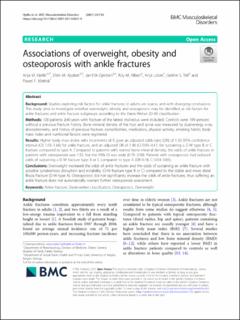| dc.contributor.author | Hjelle, Anja Myhre | |
| dc.contributor.author | Apalset, Ellen M. | |
| dc.contributor.author | Gjertsen, Jan-Erik | |
| dc.contributor.author | Nilsen, Roy M. | |
| dc.contributor.author | Lober, Anja | |
| dc.contributor.author | Tell, Grethe S. | |
| dc.contributor.author | Pawel, Mielnik | |
| dc.coverage.spatial | Norway, Sogn og Fjordane | en_US |
| dc.date.accessioned | 2021-10-13T13:17:23Z | |
| dc.date.available | 2021-10-13T13:17:23Z | |
| dc.date.created | 2021-09-10T11:21:49Z | |
| dc.date.issued | 2021 | |
| dc.identifier.citation | Hjelle, A. M., Apalset, E. M., Gjertsen, J.-E., Nilsen, R. M., Lober, A., Tell, G. S., & Mielnik, P. F. (2021). Associations of overweight, obesity and osteoporosis with ankle fractures. BMC Musculoskeletal Disorders, 22(1). | en_US |
| dc.identifier.issn | 1471-2474 | |
| dc.identifier.uri | https://hdl.handle.net/11250/2799839 | |
| dc.description.abstract | Background
Studies exploring risk factors for ankle fractures in adults are scarce, and with diverging conclusions. This study aims to investigate whether overweight, obesity and osteoporosis may be identified as risk factors for ankle fractures and ankle fracture subgroups according to the Danis-Weber (D-W) classification.
Methods
108 patients ≥40 years with fracture of the lateral malleolus were included. Controls were 199 persons without a previous fracture history. Bone mineral density of the hips and spine was measured by dual-energy x-ray absorptiometry, and history of previous fracture, comorbidities, medication, physical activity, smoking habits, body mass index and nutritional factors were registered.
Results
Higher body mass index with increments of 5 gave an adjusted odds ratio (OR) of 1.30 (95% confidence interval (CI) 1.03–1.64) for ankle fracture, and an adjusted OR of 1.96 (CI 0.99–4.41) for sustaining a D-W type B or C fracture compared to type A. Compared to patients with normal bone mineral density, the odds of ankle fracture in patients with osteoporosis was 1.53, but the 95% CI was wide (0.79–2.98). Patients with osteoporosis had reduced odds of sustaining a D-W fracture type B or C compared to type A (OR 0.18, CI 0.03–0.83).
Conclusions
Overweight increased the odds of ankle fractures and the odds of sustaining an ankle fracture with possible syndesmosis disruption and instability (D-W fracture type B or C) compared to the stable and more distal fibula fracture (D-W type A). Osteoporosis did not significantly increase the odds of ankle fractures, thus suffering an ankle fracture does not automatically warrant further osteoporosis assessment. | en_US |
| dc.language.iso | eng | en_US |
| dc.publisher | BioMed Central | en_US |
| dc.rights | Navngivelse 4.0 Internasjonal | * |
| dc.rights.uri | http://creativecommons.org/licenses/by/4.0/deed.no | * |
| dc.title | Associations of overweight, obesity and osteoporosis with ankle fractures | en_US |
| dc.type | Peer reviewed | en_US |
| dc.type | Journal article | en_US |
| dc.description.version | publishedVersion | en_US |
| dc.rights.holder | © 2021 The Authors | en_US |
| dc.source.pagenumber | 1-10 | en_US |
| dc.source.volume | 22 | en_US |
| dc.source.journal | BMC Musculoskeletal Disorders | en_US |
| dc.source.issue | 1 | en_US |
| dc.identifier.doi | 10.1186/s12891-021-04607-9 | |
| dc.identifier.cristin | 1933176 | |
| cristin.ispublished | true | |
| cristin.fulltext | original | |
| cristin.qualitycode | 1 | |

